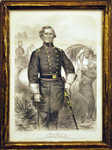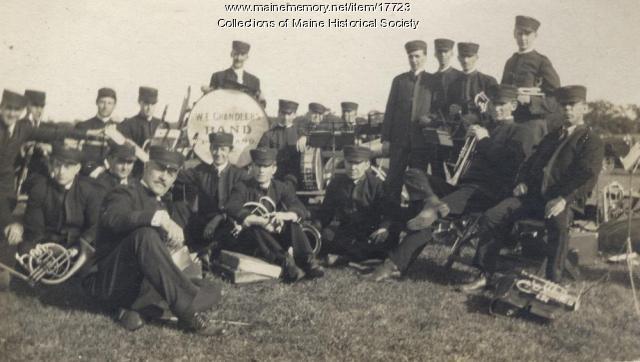Keywords: Regimental Histories
- Historical Items (637)
- Tax Records (0)
- Architecture & Landscape (0)
- Online Exhibits (43)
- Site Pages (52)
- My Maine Stories (4)
- Lesson Plans (0)
Online Exhibits
Your results include these online exhibits. You also can view all of the site's exhibits, view a timeline of selected events in Maine History, and learn how to create your own exhibit. See featured exhibits or create your own exhibit
Exhibit
Britain was especially interested in occupying Maine during the Colonial era to take advantage of the timber resources. The tall, straight, old growth white pines were perfect for ships' masts to help supply the growing Royal Navy.
Exhibit
The British capture and occupation of Eastport 1814-1818
The War of 1812 ended in December 1814, but Eastport continued to be under British control for another four years. Eastport was the last American territory occupied by the British from the War of 1812 to be returned to the United States. Except for the brief capture of two Aleutian Islands in Alaska by the Japanese in World War II, it was the last time since 2018 that United States soil was occupied by a foreign government.
Exhibit
Monuments to Civil War Soldiers
Maine supplied a huge number of soldiers to the Union Army during the Civil War -- some 70,000 -- and responded after the war by building monuments to soldiers who had served and soldiers who had died in the epic American struggle.
Exhibit
A Soldier's Declaration of Independence
William Bayley of Falmouth (Portland) was a soldier in the Continental Army, seeing service at Ticonderoga, Valley Forge, Monmouth Court House, and Saratoga, among other locations. His letters home to his mother reveal much about the economic hardships experienced by both soldiers and those at home.
Exhibit
Westbrook Seminary: Educating Women
Westbrook Seminary, built on Stevens Plain in 1831, was founded to educate young men and young women. Seminaries traditionally were a form of advanced secondary education. Westbrook Seminary served an important function in admitting women students, for whom education was less available in the early and mid nineteenth century.
Exhibit
Presque Isle and the Civil War
Presque Isle had fewer than 1,000 residents in 1860, but it still felt the impact of the Civil War. About half of the town's men went off to war. Of those, a third died. The effects of the war were widespread in the small community.
Exhibit
This collection of images portrays many buildings in Sanford and Springvale. The images were taken around the turn of the twentieth century.
Exhibit
Music in Maine - Drum, Portland, ca. 1854
"… making maple drums during the Civil War for Union Regiments. Civil War drums were generally sixteen inches in diameter, smaller than prior drums by…"
Exhibit
Music in Maine - Civil War drum, ca. 1861
"… style side drum in the 10th and 17th Maine Regiments from October 4, 1861 to March 11, 1862, when he was discharged for disability."
Exhibit
Music in Maine - Kimball Drum, ca. 1860
"F of the 5th Maine Infantry Regiment. The writing probably was added by Maine Historical Society Librarian Nathan Goold."
Exhibit
Port of Portland's Custom House and Collectors of Customs
The collector of Portland was the key to federal patronage in Maine, though other ports and towns had collectors. Through the 19th century, the revenue was the major source of Federal Government income. As in Colonial times, the person appointed to head the custom House in Casco Bay was almost always a leading community figure, or a well-connected political personage.
Exhibit
Music in Maine - Military Marching Bands
"… the Civil War, when members served as the First Regimental Band. Daniel Chandler and other musicians s split from the Portland Band in 1873, when…"
Exhibit
Rum, Riot, and Reform - Neal Dow
"… his campaign to the front by forming his own dry regiment, the 13th Maine. The Colonel was eventually taken prisoner. On July 4, 1863, Capt."
Exhibit
A Convenient Soldier: The Black Guards of Maine
The Black Guards were African American Army soldiers, members of the segregated Second Battalion of the 366th Infantry sent to guard the railways of Maine during World War II, from 1941 to 1945. The purpose of the Black Guards' deployment to Maine was to prevent terrorist attacks along the railways, and to keep Maine citizens safe during the war.
Exhibit
Shepard Cary: Lumberman, Legislator, Leader and Legend
Shepard Cary (1805-1866) was one of the leading -- and wealthiest -- residents of early Aroostook County. He was a lumberman, merchant, mill operator, and legislator.
Exhibit
Before the era of recorded music and radio, nearly every community had a band that played at parades and other civic events. Fire departments had bands, military units had bands, theaters had bands. Band music was everywhere.
Exhibit
Promoting Rockland Through a Stereopticon, 1875
Frank Crockett and photographer J.P. Armbrust took stereo views of Rockland's downtown, industry, and notable homes in the 1870s as a way to promote tourism to the town.
Exhibit
Student Exhibit: Historic Buildings on Madison Ave in Skowhegan
Take a tour and see some of the beautiful old buildings that used to be on Madison Avenue, Skowhegan? A few still remain, but most have been torn down.
Exhibit
Begin Again: reckoning with intolerance in Maine
BEGIN AGAIN explores Maine's historic role, going back 528 years, in crisis that brought about the pandemic, social and economic inequities, and the Black Lives Matter movement in 2020.



















